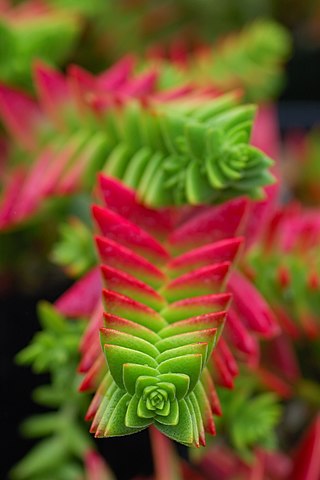
The International Union for Conservation of Nature (IUCN) Red List of Threatened Species, also known as the IUCN Red List or Red Data Book, founded in 1964, is the world's most comprehensive inventory of the global conservation status of biological species. It uses a set of precise criteria to evaluate the extinction risk of thousands of species and subspecies. These criteria are relevant to all species and all regions of the world. With its strong scientific base, the IUCN Red List is recognized as the most authoritative guide to the status of biological diversity. A series of Regional Red Lists are produced by countries or organizations, which assess the risk of extinction to species within a political management unit.

Crassula is a genus of succulent plants containing about 200 accepted species, including the popular jade plant. They are members of the stonecrop family (Crassulaceae) and are native to many parts of the globe, but cultivated varieties originate almost exclusively from species from the Eastern Cape of South Africa.

The conservation status of a group of organisms indicates whether the group still exists and how likely the group is to become extinct in the near future. Many factors are taken into account when assessing conservation status: not simply the number of individuals remaining, but the overall increase or decrease in the population over time, breeding success rates, and known threats. Various systems of conservation status exist and are in use at international, multi-country, national and local levels as well as for consumer use.

Cyphostemma juttae is a slow-growing succulent species of Cyphostemma from southern Africa, well known as an ornamental plant.

An IUCN Red List Critically Endangered species is one that has been categorized by the International Union for Conservation of Nature as facing an extremely high risk of extinction in the wild. As of 2021, of the 120,372 species currently tracked by the IUCN, there are 8,404 species that are considered to be Critically Endangered.
Anginon is a genus of flowering plant in the family Apiaceae. It is endemic to southern Africa.
Hypericum acostanum is a species of flowering plant in the family Hypericaceae. It is endemic to Ecuador, where it is known only from Loja.
Hypericum asplundii is a species of flowering plant in the family Hypericaceae. It is endemic to Ecuador, where it is known from a single collection made outside of Machachi.
Hypericum balfourii is a species of flowering plant in the family Hypericaceae. It is endemic to Socotra, an island archipelago that is part of Yemen. It grows in mountain shrubland dominated by Cephalocroton. It is usually found on granite terrain above 600 meters in elevation.
Hypericum fieriense is a species of flowering plant in the St. John's wort family Hypericaceae. It is endemic to Socotra, an island archipelago that is part of Yemen. It grows in mountain shrubland dominated by Cephalocroton, where it can be found with the endemic tree Dracaena cinnabari. It is rarer than other local shrubby Hypericum species. It can be distinguished from them by its pubescent herbage.
Hypericum hartwegii is a species of flowering plant, a shrub in the St. John's wort family Hypericaceae. It is endemic to Ecuador. It was collected twice in 1841 in Loja Province, and it has not been seen since.
Hypericum quitense is a species of flowering plant in the family Hypericaceae. It is endemic to Ecuador. Its occurs in several types of habitats at elevations between 2,000 and 4,050 meters in the Andes.

Hypericum scopulorum is a species of flowering plant in the family Hypericaceae. It is endemic to Socotra, an island archipelago that is part of Yemen. It is a common plant in shrubland habitat, and it is a dominant species in some areas along with Cephalocroton and another local endemic, Helichrysum rosulatum.

Helicia is a genus of 110 species of trees and shrubs, constituting part of the plant family Proteaceae. They grow naturally in rainforests throughout tropical South and Southeast Asia, including India, Sri Lanka, Indochina, Peninsular Malaysia to New Guinea and as far south as New South Wales.

Ocotea porosa, commonly called imbuia or Brazilian walnut, is a species of plant in the Lauraceae family. Its wood is very hard, and it is a major commercial timber species in Brazil.
Passiflora ampullacea is a species of plant in the family Passifloraceae. The vine is endemic to Ecuador. It is an IUCN Red List threatened species.
Passiflora anfracta is a species of flowering plant in the Passifloraceae family. It is a passion flower that is endemic to Ecuador.
Passiflora deltoifolia is a species of plant in the family Passifloraceae. It is endemic to Ecuador.
Passiflora zamorana is a species of plant in the family Passifloraceae. It is endemic to Ecuador.

Tabernaemontana pandacaqui, known as windmill bush and banana bush, is a species of plant in the dogbane family Apocynaceae.








